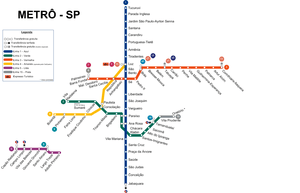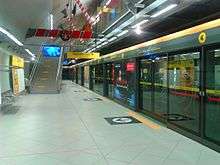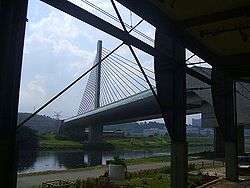São Paulo Metro
 | |||
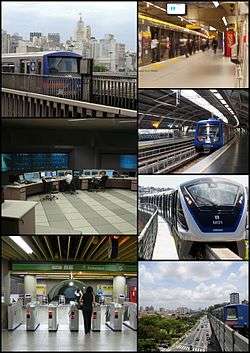 | |||
| Overview | |||
|---|---|---|---|
| Native name | Metrô de São Paulo | ||
| Locale | São Paulo, Brazil | ||
| Transit type | Rapid transit | ||
| Number of lines |
5 rapid transit lines[1] 1 monorail line[1] (Lines 4, 5, 15 in expansion) | ||
| Number of stations |
65[1] (66, including Line 15) | ||
| Daily ridership | 4.6 million[1] | ||
| Annual ridership |
895.6 million (FY 2014, Lines 1, 2, 3 & 5)[2] | ||
| Website | São Paulo Metrô (English) | ||
| Operation | |||
| Began operation | September 14, 1974 | ||
| Operator(s) |
Companhia do Metropolitano de São Paulo (Lines 1-3, 5 & 15) ViaQuatro (Line 4) | ||
| Technical | |||
| System length | 78.4 km (48.7 mi) (metro only) | ||
| Track gauge |
1,600 mm (5 ft 3 in) (Lines 1-3) 1,435 mm (4 ft 8 1⁄2 in) (Lines 4-5) | ||
| Top speed |
100 km/h (62 mph) (Lines 1-3) 80 km/h (50 mph) (Lines 4-5) | ||
| |||
The São Paulo Metrô (Portuguese: Metropolitano de São Paulo), commonly called the Metrô, is the main rapid transit system in the city of São Paulo and the largest in Brazil. It is also the second largest system in South America and the third largest in Latin America, behind the Mexico City Metro and the Santiago Metro. The five main lines in the metro system system (Lines 1, 2, 3, 4 & 5) operate on 78.4 kilometres (48.7 mi) of route, serving 65 stations.[1] A sixth line, Line 15, is a monorail line that partially opened for service in 2014.[1] In 2014, the four lines operated by CMSP (Lines 1, 2, 3 & 5) achieved an average weekday ridership of 3.09 million,[2] and provided 895.6 million rides over the course of 2014;[2] the entire Metro system served 1,098 million passengers when Line 4 is included with the other four lines.
The Companhia do Metropolitano de São Paulo (Metrô) was founded on April 24, 1968.[1] Eight months later, work on North-South line was initiated. In 1972, the first test train trip occurred between Jabaquara and Saúde stations. In 1974, the segment between Jabaquara and Vila Mariana entered into commercial operation.[1]
The system is interlinked with CPTM (São Paulo Metropolitan Trains Company) at Brás, Palmeiras-Barra Funda, Tatuapé, Corinthians-Itaquera, Tamanduateí, Pinheiros and Santo Amaro stations, and at other modal transportation terminals in the city of São Paulo.[3] The São Paulo Metro was voted Best Metro Americas at the MetroRail 2010 industry conference.[4][5][6][7]
Lines
The metro system consists of five color-coded lines: Line 1 (Blue), Line 2 (Green), Line 3 (Red), Line 4 (Yellow), and Line 5 (Lilac), all of them operating from Sunday to Saturday, from 4:40 AM to midnight (1:00 AM on Saturdays). The metro system carries 4,500,000 passengers a day.[1] A sixth line, Line 15 (Silver), is a monorail, a section of which (the rest being currently under construction) is presently open for service on weekends only.
Metro itself is far from covering the entire urban area in the city of São Paulo and only runs within the city limits. Another company, Companhia Paulista de Trens Metropolitanos (CPTM), serves 22 municipalities that make up the São Paulo Metropolitan Region with commuter lines, which total six lines (7, 8, 9, 10, 11 and 12), 258.4-kilometre (160.6 mi) long, serving 92 stations and carrying 2,900,000 passengers a day. Metro and CPTM are integrated through various stations. Metro and CPTM both operate as State-owned companies, and have received awards in the recent past as one of the cleanest systems in the world by ISO9001. The times between the trains both in Metro and CPTM are about one-two minutes in the high traffic times, and three-five minutes in the low traffic periods. The CPTM differs from Metro because it serves other municipalities around São Paulo and also cargo trains, and because of the considerably larger distance between stations (except for the Line 9, which has almost no differences to the Metro lines).
The first line, Norte/Sul (North/South), later renamed "Blue Line" or Line 1 - Blue, was opened on September 18, 1972, with an experimental operation between Saúde and Jabaquara stations. Commercial operations started on September 14, 1974, after an eight-year "gestation" period that began in 1966, under Mayor Faria Lima's administration. Expansion of the metro system includes new lines. As of late 2004, construction began on a US$1 billion, 12.8 km (7.9 mi) all-underground line (Line 4 - Yellow), with eleven stations, aimed at transporting almost one million people per day. By 2004, Line 2 was also being expanded, with two new stations open in 2006 and another one in 2007.
An 10.5-kilometre (6.5 mi) expansion of Line 5 is currently under construction. Plans also include updating the CPTM suburban rail system, which will add several million passengers capacity into the system. It is expected that the São Paulo Metro and CPTM systems will carry about 9.3 million people on average week days by 2018, as opposed to today's 7.5 million (Metro: 4.6 million; CPTM: 2.9 million as of 2014). Metro stations operate from 4:40 AM to around 12:00 AM. As of January 2015, tickets cost R$3.50. In 2006, the São Paulo Metro system has started to use a smart card, called "Bilhete Único" (or "Single Ticket" in English).
Current operational data
Its current extension does not cover all the areas in the city, however, the subway network, with five lines (three of which are undergoing construction for extensions), is complemented by a network of metropolitan trains of 258.4 km (162 mi), divided into six lines operated by CPTM, which serve the capital and other cities in the Greater São Paulo, extending up to Jundiaí, Osasco, Santo André, Mogi das Cruzes, Ferraz de Vasconcelos, and others.[8] Metro is funded by the São Paulo State government and is run by a special self-administered organisation. In terms of service the lines are generally average compared to international standards although certain more prominent lines and stations such as the Yellow Line and the downtown stations feature much more capable infrastructure due to their expected high use and run much more quickly and efficiently while less used lines are historically given less attention and usually run a lesser number of cars. The São Paulo State government has begun to address this issue and is currently building more lines and stations in farther out areas and ordering more cars to run on lines already in service with increase in funding that the state government has been receiving in recent years due to the growth of the Brazilian economy.
Conversion of metropolitan lines to surface metro
This project of conversion of lines to metro arose due to the high demand of passengers who use the metropolitan lines of CPTM and the need to recover the old stations.
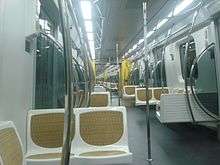
Currently, there are old 19th century stations that were never modernised. With the extreme need to recover stations, it appeared that the plan of conversion, which is nothing but the modernisation of the stations, purchase of new trains and reduction of headway to less than three minutes, as international standards.
Between the end of the 1990s and the early 2000s, with this project of refurbishing the CPTM lines, inherited from the RFFSA (Federal Railway Network) and Fepasa (former São Paulo State Railways), the conversion of some metropolitan lines to Metro standard began. This experience started in Line E, in the stretch known as "East Express", serving the east end of São Paulo City and running parallel to Line 3 - Red. The stretch completed (to Guaianazes station) today has new and modern trains and stations with a new route in the final part. The next stretch to be built, between Guaianazes station, in São Paulo City, and Estudantes in Mogi das Cruzes, also covering the municipalities of Ferraz de Vasconcelos, Suzano and Poá, is estimated to have its works resumed in 2007, but this was again postponed, now to 2008. Currently, all CPTM lines, with exception of Line 7 and Line 8, are working as full Metro system.
Bus terminals
In May 1977, Metro assumed the administration and commercial utilization of the Inter-City Jabaquara Intermunicipal Terminal, and inaugurated, in May 1982, the modern Inter-city Tietê Bus Terminal, replacing the former Júlio Prestes Terminal.
This agreement established that Metro would be in charge of the studies for the planning, implementation, and operation of passenger transportation in the municipal district of São Paulo, either directly or through third parties.
Later, the other inter-city bus terminals were integrated into the system, such as Bresser, in January 1988, and Palmeiras-Barra Funda, in December 1989. In January 1990 the inter-city bus terminals were outsourced by Metrô, which through public bidding, contracted Consortium Prima for the administration and commercial utilization of the 4 inter-city bus terminals of the city of São Paulo. This contract included the responsibility for maintenance and conservation of the existing installations, as well as of the expansion and modernisation of the terminals.[9]
Rolling stock

The first cars started operating in 1974, the same year the company commercial activities were initiated. It was originally made in USA, by The Budd Company, and the national building company Mafersa take the prototype to factory the model in large scale, such the rest of 50 compositions they're all the same. The model was programmed to be used along the North-South line, such known as Line 1 (São Paulo Metro).
The initial idea was using two cars during a low demand operation, then attaching those to others as the demand increased, up to a maximum of six-cars. All of them have a pair of electric engines and a cabin. This model was named series 100, whose cars received the numbers of 1001 to 1306 (51 trains by 6 cars each).

In the end, the six-car formation train got standardized. Currently, this fleet is known by "A Fleet", and is planned to be entirely phased out by the beginning of 2015, as the recent modernization processes saw them being converted into two different fleets: I and J. This conversion,in January 2016, was still unfinished.
To reduce the manufacturing cost, the Cobrasma company decided to provide, for the East-West Line Line 3 (São Paulo Metro), trains with two cabins only and making use of more advanced ventilation and maintenance systems. This fleet is known by the name of "C". The batch of trains designed for this line were produced by two different national companies, Cobrasma and Mafersa (whose trains got named as "D").
The only difference between the two is the front mask and some structural framework. Their technical nomenclature is 300. According to it, the C fleet has trains with numbers from 301 (C01) to 325 (C25), and the D fleet has trains numbered 326(D26) to 347(D47). Great part of C fleet trains were already refurbished, as K fleet (or L fleet, for the D cars).
Security
Metro's security agents have police powers and in case of need they will provide assistance. All police matters that occur within the system are directed to the police station of the subway system, DELPOM (Delegacia de Polícia do Metropolitano de São Paulo), located at Palmeiras-Barra Funda station.[10]
System lines
| Line | Color | Termini | Opened | Length | Stations | Duration of trip (min) |
Hours of Operation |
|---|---|---|---|---|---|---|---|
| Line 1 | Blue | Tucuruvi ↔ Jabaquara | September 14, 1974 | 20.2 km (12.6 mi) | 23 | 45 | Daily (4:40 AM–0:32 AM) |
| Line 2 | Green | Vila Madalena ↔ Vila Prudente | January 25, 1991 | 14.6 km (9.1 mi) | 14 | 18 | Daily (4:40 AM–0:32 AM) |
| Line 3 | Red | Palmeiras-Barra Funda ↔ Corinthians-Itaquera | March 10, 1979 | 22.0 km (13.7 mi) | 18 | 36 | Daily (4:40 AM–0:32 AM) |
| Line 4[11] | Yellow | Butantã ↔ Luz | May 25, 2010 | 12.8 km (8.0 mi) | 11 | 15 | Daily (4:40 AM–0:32 AM) |
| Line 5[12] | Lilac | Capão Redondo ↔ Adolfo Pinheiro | October 20, 2002 | 9.3 km (5.8 mi) | 7 | 13 | Daily (4:40 AM–0:32 AM) |
| Line 15 | Silver (Monorail) |
Vila Prudente ↔ Oratório | August 30, 2014 | 2.9 km (1.8 mi) | 2 | 4 | Daily (9:00 AM–2:00 PM) |
Future developments
Several conventional metro and monorail lines are currently under construction or under project.
| Extension for | Color | Termini | Opened | Length | Stations |
|---|---|---|---|---|---|
| Line 4[11] | Yellow | Largo do Taboão ↔ Vila Sônia | Planned | 2.0 km (1.2 mi) | 2 |
| Line 5[12] | Lilac | Adolfo Pinheiro ↔ Chácara Klabin | Under construction | 10.4 km (6.5 mi) | 10 |
| Line 15[13] | Silver (Monorail) | Oratório ↔ Hospital Cidade Tiradentes | Under construction | 20.9 km (13.0 mi) | 15 |
| Line 15 | Silver (Monorail) | Ipiranga ↔ Vila Prudente | Planned | 1.9 km (1.2 mi) | 2 |
| Line | Color | Termini | Length | Stations |
|---|---|---|---|---|
| Line 17[14] | Gold (Monorail) | São Paulo - Morumbi ↔ Congonhas / Jabaquara | 21.5 km (13.4 mi) | 20 |
| Line | Color | Termini | Length | Stations |
|---|---|---|---|---|
| Line 6[15] | Orange | Brasilândia ↔ São Joaquim | 15 km (9.3 mi) | 15 |
| Line 2[16] | Green (Expansion) | Vila Prudente ↔ Dutra | 14 km (8.7 mi) | 9 |
| Line 18[17] | Bronze (Monorail) | Tamanduateí ↔ Alvarengas | 20 km (12 mi) | 18 |
| Line 19[18] | Sky Blue | Tancredo Neves ↔ Campo Belo | ||
| Line 20[18] | Pink | Lapa ↔ Moema | 12.3 km (7.6 mi)[19] | 13 |
See also
- List of São Paulo Metro stations
- Companhia Paulista de Trens Metropolitanos - São Paulo's Metropolitan Train Company
- Transport in São Paulo
- List of Latin American rail transit systems by ridership
- List of metro systems
- List of monorail systems
References
- 1 2 3 4 5 6 7 8 9 "Metrô - Home - The Company - About". Companhia Do Metropolitano De São Paulo. 2015. Retrieved 2015-01-23.
- 1 2 3 "Metrô - Demanda de passageiros" [Passenger demand] (in Portuguese). Companhia Do Metropolitano De São Paulo. 2014. Retrieved 2014-06-14.
- ↑ Expansion Archived January 30, 2010 at the Wayback Machine
- ↑ "9 Of The World's Best Subways (PHOTOS)". Huffington Post. April 12, 2010.
- ↑ MetroRail announced in 2010 on the SP Metro choice as the best of America, in London
- ↑ Metros award 2010
- ↑ Publication of the award in the site ExpansãoSP-Metrô
- ↑ Metropolitan Map of São Paulo
- ↑ Bus Terminals - São Paulo Metro
- ↑ Security in São Paulo Metro
- 1 2 http://www.metro.sp.gov.br/obras/linha-4-amarela/index.aspx
- 1 2 http://www.metro.sp.gov.br/obras/linha-5-lilas/index.aspx
- ↑ http://www.metro.sp.gov.br/obras/monotrilho-linha-15-prata/video-apresentacao.aspx
- ↑ http://www.metro.sp.gov.br/obras/linha-17-ouro/index.aspx
- ↑ http://www.expansao.sp.gov.br/metro_linha_laranja.php[]
- ↑ http://www.expansao.sp.gov.br/metro_linha_branca.php[]
- ↑ http://www.aeamesp.org.br/bblt/16s/d4programa.aspx Associação dos Engenheiros e Arquitetos do Metrô de S. Paulo - 16ª Semana da Tecnologia Metroferroviária - 16 de setembro de 2010, Palestra : Metroleve ABC-SP
- 1 2 http://www.domboscoitaquera.org.br/downloads/secretaria_estadual_de_transportes.pdf Seminário sobre infraestrutura e sistema viário para a copa 2014 e o desenvolvimento da zona leste, Jurandir Fernandes, Secretário dos Transportes Metropolitanos, 25/08/2011
- ↑ http://www.sinaenco.com.br/downloads/Marcelo%20Peixoto%20SP.pdf Parcerias Público-Privadas do Estado de São Paulo
External links
| Wikimedia Commons has media related to São Paulo Metro. |
- São Paulo Metro website
- State Transport Secretariat website (Portuguese)
- Find places near the subway stations (Portuguese)
- Essential Network of São Paulo Metro (project of extension of the network to be ready by 2025) (Portuguese)
- CityMayors article
| ||||||||||||||||||||||||||||||||||||||||||
| ||||||||||||||||||||||||||||
| ||||||||||||||||||||||
